Maturing COVID loans push PH debt to limit: Did we benefit?
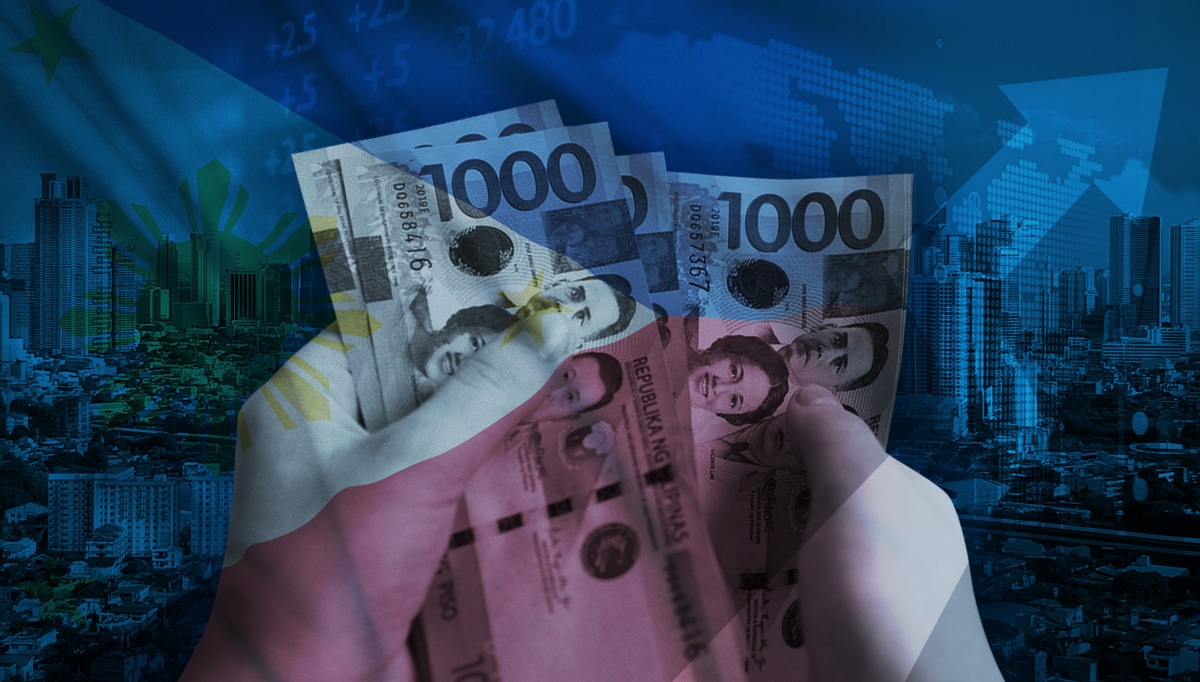
PH DEBT composite image from Inquirer file photos
MANILA, Philippines—COVID drove the Philippine economy to a standstill in 2020, killing hundreds of people and opening the doors to government borrowings that reached billions of pesos and are maturing soon to add to the country’s record-breaking debt burden.
This eventually brought the government’s outstanding debt to a record-high of P12.79 trillion in mid-2022, the end of the presidency of Rodrigo Duterte and the start of Ferdinand Marcos Jr.’s.
But even with the end of the pandemic, the country’s obligations keep on swelling, with the outlook set at P16.06 trillion in 2024 and P17.35 trillion in 2025 since most of the COVID-19 loans are still being settled.
READ: Recto: Debt under Marcos high as gov’t also paying pandemic loans
Last year, with the P1.82 trillion borrowed since Marcos took office, the outstanding debt hit a new record-high of P14.62 trillion, higher than the P13.42 trillion in 2022, according to data from the Bureau of the Treasury.
Article continues after this advertisement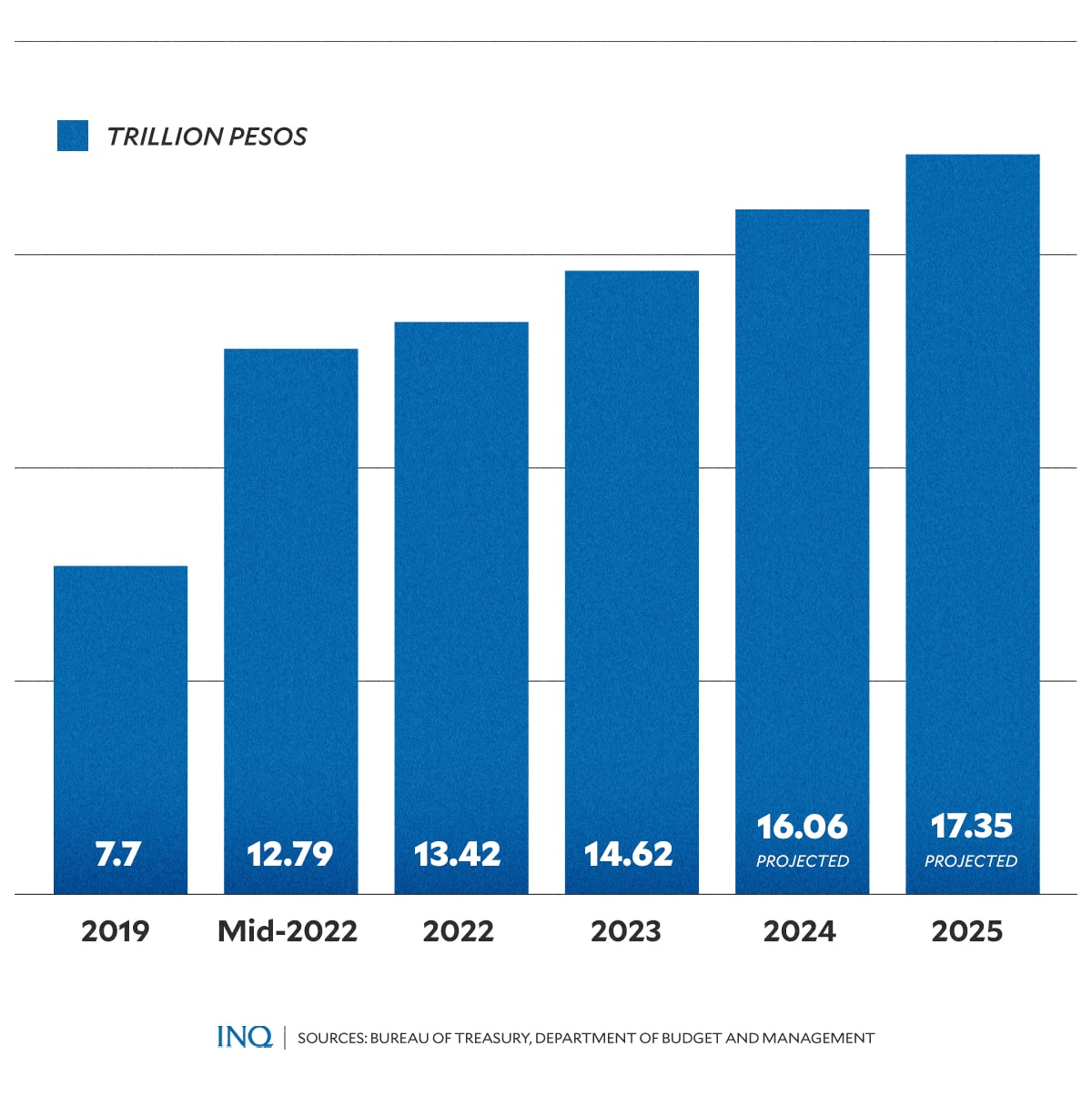
GRAPHIC Ed Lusta
The Department of Budget and Management (DBM) explained that the government relied on borrowings when COVID-19 hit. The debt level, however, is expected to go down once it reaches its peak.
Article continues after this advertisementDebt-to-GDP (gross domestic product) ratio, or debt compared to the economic value of the country, was 60.2 percent in 2023, slightly lower than the 60.9 percent in 2022 and 60.4 percent in 2021.
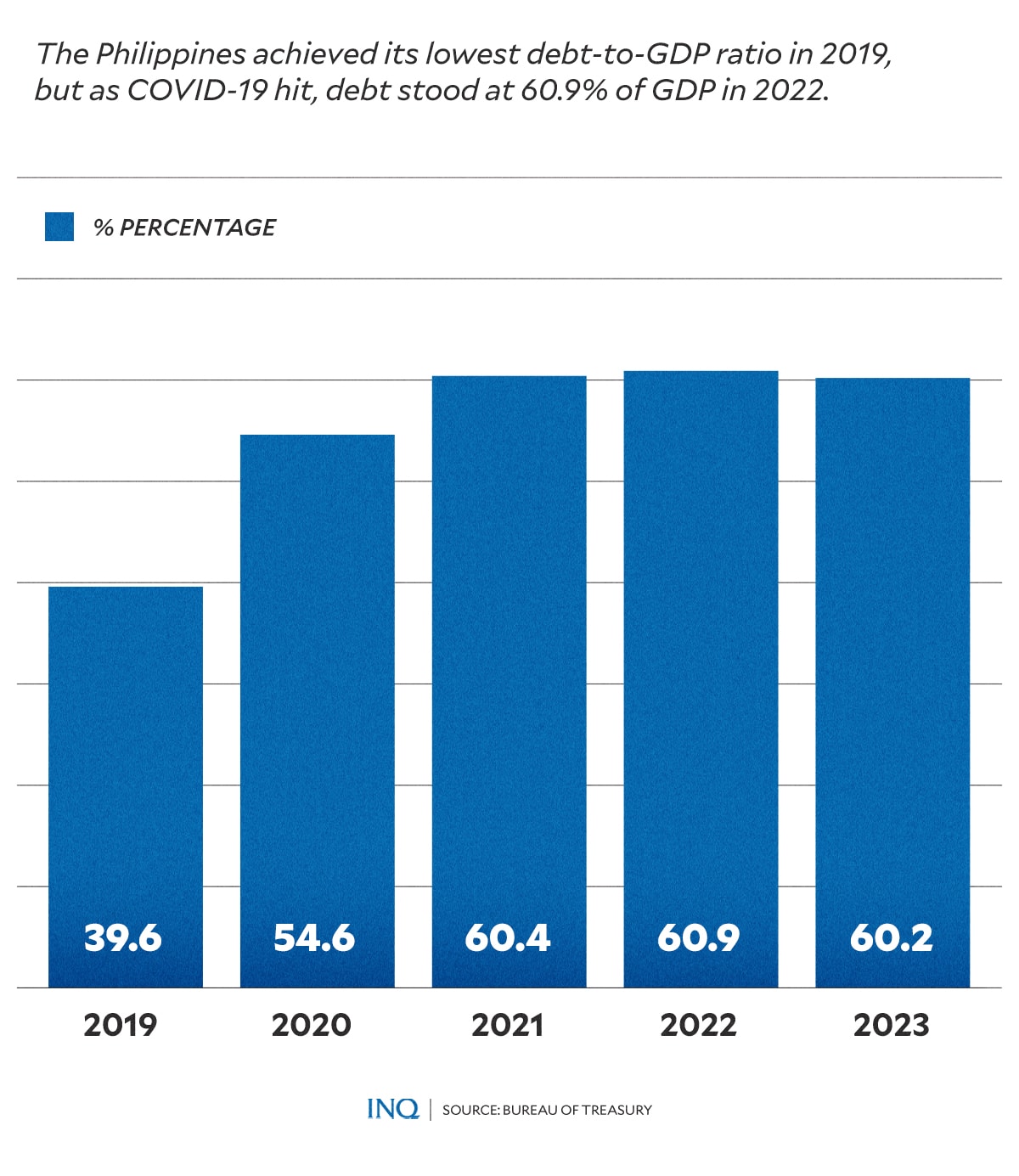
GRAPHIC Ed Lustan
But while the government somehow pointed out that it can settle its obligations, especially with the economy “growing even stronger,” Filipinos still ask: Where did all the resources go?
Pile of obligation
As of May 2022, the Department of Finance (DOF) said that a fiscal consolidation and resource mobilization plan is required to reverse in 10 years the P3.2 trillion debt that was incurred because of the pandemic.
But based on its own data in the first month of 2022, the DOF said that $25.8 billion, or P1.46 trillion, was “secured” for COVID-19 response, including the grant and loan financing that was received for some COVID-19 programs.
Most of the contracted financing, it said, were from the Asian Development Bank (ADB), World Bank (WB), Asian Infrastructure Investment Bank (AIIB), Japan International Cooperation Agency (JICA), and the Agence Française de Développement.
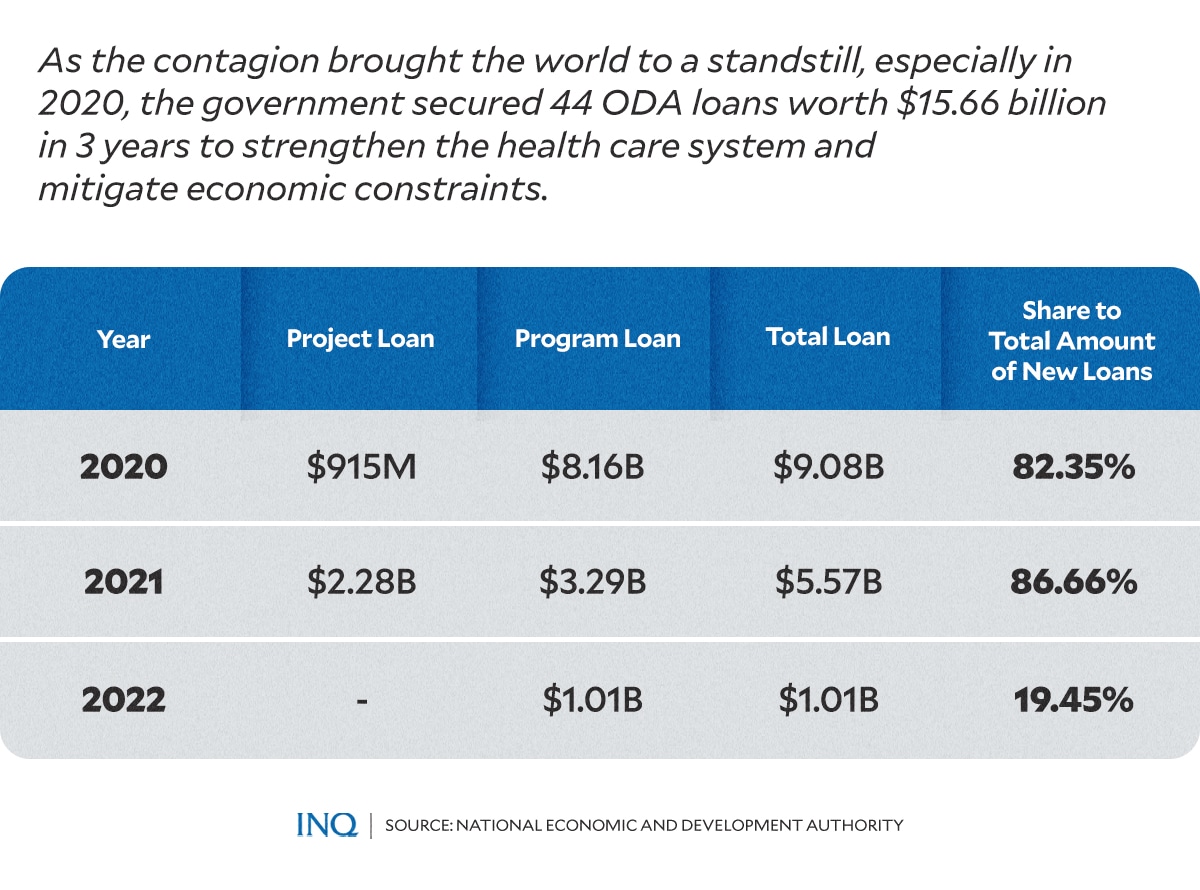
GRAPHIC Ed Lustan
Based on data from the National Economic and Development Authority, $15.66 billion, or P886.51 billion, were classified as Official Development Assistance (ODA) loans, or those that are administered to promote sustainable development.
It said that from 2020 to 2022, the government secured 44 ODA loans for COVID-19 response—25 (worth $9.08 billion) in 2020, 15 (worth $5.57 billion) in 2021, and 4 (worth $1.01 billion) in 2022.
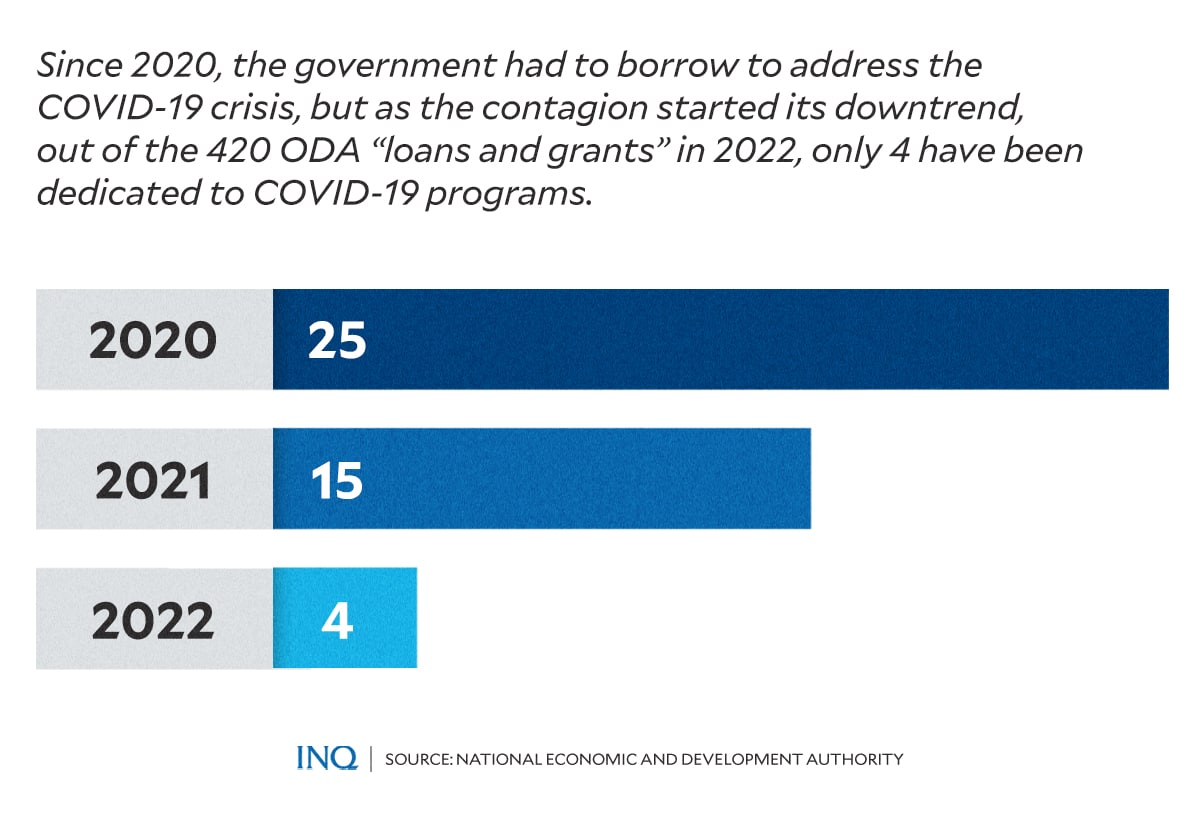
GRAPHIC Ed Lustan
The government had said that its active list of ODA loans is reflective of its commitment to address the socioeconomic scarring brought by the COVID-19 crisis and secure assistance for economic transformation.
‘Not really for COVID’
But as pointed out by the think tank Ibon Foundation, the $25.74 billion, or P1.46 trillion, which the government said was borrowed to address the COVID-19 crisis, was not entirely spent for pandemic response:
- 23 percent, or $5.64 billion: “Explicitly for COVID-19 response”
- 26 percent, or $13.28 billion: “Not necessarily for COVID-19 response”
- 26 percent, or $6.82 billion: “Self-evidently not for COVID-19 response even if reported as such”
Sonny Africa, an economist and executive director of Ibon Foundation, told INQUIRER.net that the government “borrowing[s] was not primarily for COVID-19 response.”
“It would be more accurate to say that the government incurred so much debt […] to make up for the revenue contraction due to the protracted lockdowns and to be able to continue payments in infrastructure and for debt service,” he said.
As context, the government collected P3.14 trillion in revenues in 2019. Because of the lockdowns, revenues fell to P2.86 trillion in 2020 and P3 trillion in 2021, the think tank said.
By the end of 2021, the DBM reported only P616 billion disbursed for COVID-19 response, while in 2020 to 2021, spending for infrastructure was at P1.9 trillion; debt interest payments at P950 billion; and principal amortization at P1.3 trillion.
‘Not transparent enough’
The problem, however, is not only whether the loans were spent on COVID-19 response because, as pointed out in a report published by the United Nations, the lack of transparency was seriously concerning, too.
The report “COVID-19, Lies and Statistics: Corruption and the Pandemic,” first published on the Science and Development Network, stated that “from Brazil to the Philippines,” the crisis was responded to by “secretive governments.”
“Clandestine contracts for medical goods and services have become the norm in many countries,” it said while stressing the “lack of transparency,” especially in procurements.
Since 2021, the Philippine Senate has called on the government to provide a complete accounting of the billions worth of resources for the procurement of COVID-19 vaccines.
“The[re] is the responsibility to disclose the details of the billions spent for them,” now Senate President Chiz Escudero had said while pointing out that “the vaccines do not carry an immunity from accountability.”
As stressed in 2021 by then senator Franklin Drilon, “we need transparency in government spending,” saying that “we need the crucial information on […] what we’re buying, what brand, from whom, at what cost and quantity.”
Veil of secrecy
Back in 2020, in a bid to vaccinate 60 million Filipinos, the government allocated P82.5 billion for vaccine procurement—P72.5 billion in the 2021 General Appropriations Act (GAA) and P10 billion in the Bayanihan to Recover as One Act.
However, only 2.5 billion of the P72.5 billion was guaranteed in the 2021 GAA, so the rest had to be sourced from loans. The government asked for P25 billion more in June 2021, and then P55 billion in 2022 for “booster shots”.
READ: Only P2.5B out of P72.5B for COVID-19 vaccines has immediate funding
But as pointed out by Escudero, details of the vaccine procurement, which the government said was covered by its non-disclosure agreements with manufacturers, has not yet been “declassified.”
RELATED STORY: Bid to lift secrecy veils on COVID vaccine costs starts as 44M doses are wasted
“If you ask government agencies how much was spent for how many, you will get different answers, if that is you get a reply. There is a report that P300 billion was spent but there was also a statement here at the Senate that it was P145 billion,” he said.
RELATED STORY: Hontiveros to DOH: Waive NDAs, disclose COVID-19 vaccine cost
Based on a report by the Senate blue ribbon committee last year, 134.15 million doses of COVID-19 vaccines have been procured by the government as of Dec. 2, 2022:
- Pfizer/BioNTech: 60 million
- Sinovac: 51.13 million
- Moderna: 13.02 million
- Sputnik-V: 10 million
Vaccine cost
Out of the 134.15 million doses procured by the national government, 118.65 million was funded through financing institutions, while the balance of 15.50 million were secured through the GAA.
Based on estimates from 2021 to 2022 for fund sources such as the ADB, WB, and the government, the average cost of a COVID-19 vaccine dose was P413.08 to P729.06 each.
- Vaccines secured through WB loans
- Pfizer and Moderna: P729.06
- Vaccines secured through GAA
- Sinovac and Sputnik: P573.729
- Vaccines secured through ADB and AIIB loans
- Sinovac and Pfizer: P413.08
As stated in the Senate report, each dose of Pfizer and Moderna vaccines cost P729.06, while those of Sinovac and Sputnik-V were worth P573.729 each, based on estimates from 2021 to 2022.
READ: Public has legal basis to demand disclosure of COVID-19 vaccine prices
As of the same period, 92.83 million doses have been donated, too, with Pfizer leading the list at 38.72 million; AstraZeneca at 22.33 million; Moderna at 13.87 million; and Johnson & Johnson at 12.73 million.
Sinovac donated 4.08 million doses. Sinopharm and Sputnik-V gave 1.11 million.
Overpriced PPEs
When COVID-19 hit, most needed, too, were the personal protective equipment (PPE) intended especially for medical workers who were taking care of people afflicted by the virus.
But back in the sixth month of the pandemic in 2020, Sen. Risa Hontiveros pointed out that the Philippines lost P1 billion when the Procurement Service of the DBM bought “overpriced” PPE sets from China.
READ: More sales for China as PH buying 3M more PPE sets, giving military daunting transport task
She said that “out of the 11 contracts […] seven were with China-based companies,” including Xuzhou Const. Machinery Group, Wen Hua Dev’t Industrial Co., Ltd., Chushen Company Ltd.; and Pacific Field (Hong Kong) Ltd.
RELATED STORY: Chinese firms profit off PH amid the pandemic
Then in 2021, the Senate investigated allegations of corruption in the contracts made by the government with the Chinese company Pharmally Pharmaceutical Corp.
The corporation was only formed months before it bagged 13 COVID-19 contracts worth P11.5 billion from the government. It was allegedly financed by Duterte’s friend and former economic adviser, Chinese businessman Michael Yang.
Based on data from the Commission on Audit, the biggest contract that Pharmally Pharmaceutical Corp. had with the government was P3.82 billion in May 2020 for millions of PPE sets worth P1,910 each.
Not enough ayuda
As the pandemic took a heavy toll on the economy, the government implemented the Social Amelioration Program of the Department of Social Welfare and Development (DSWD).
The program was expected to provide emergency assistance of between P5,000 and P8,000 a month to about 18 million low income households for two months.
As pointed out by Ibon Foundation, however, the DSWD, in its Memorandum 14-2020, added five million more households in the “wait list,” bringing the total number to 22.7 million.
READ: Surveys of ‘ayuda’
Based on survey results by the Social Weather Stations in July and October 2020, 72 percent and 71 percent of beneficiaries received “money-help” from the government since the start of the COVID-19 crisis.
But as Ibon Foundation stated, 10.6 million households were expected to get assistance for only one month because the government backtracked and eventually said that residents in areas with relaxed restrictions would not be getting the second wave of aid after all.
The aid was not substantial, too, it said, pointing out that the P98.5 billion distributed to 17.45 million households as of July 22, 2020 for the first tranche averaged to only P5,645 each household.
“This amounts to just P43 daily per family when spread over the 130 days since the lockdown was imposed,” it said.
(Watch for it in INQUIRER premium: Mike Ubac tackles growing debt burden and government capacity to pay)
For more news about the novel coronavirus click here.
What you need to know about Coronavirus.
For more information on COVID-19, call the DOH Hotline: (02) 86517800 local 1149/1150.
The Inquirer Foundation supports our healthcare frontliners and is still accepting cash donations to be deposited at Banco de Oro (BDO) current account #007960018860 or donate through PayMaya using this link.